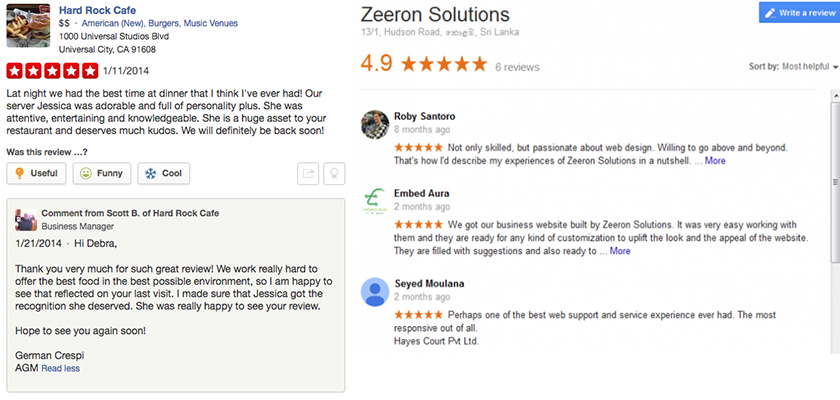
Reviews Are Getting Important – How To Maintain And Build Your Reputation As A Digital Agency
Social Proof has been quite prominent and a prevalent concept that applies to any field of business and commerce. This concept is directly correlated with the success of the brand and how the business is targeting its potential customer base.
Put yourself in your consumer’s shoes, would you prefer a product that is being marketed in the most interactive way or would you invest in a product that your friends recommend? The answer is quite simple.
This is why reviews and recommendations play an important role when it comes to the reputation of any business including a digital agency.
Social media has become one of the most powerful marketing tools in the industry today as businesses can either win the whole market or they can crash or burn.
Even a single negative review by an influencer has the capacity of discouraging existing clients and completely eliminating the chances of enticing new ones.
Below, we further delve into the metrics that define the significance of reviews and how a digital agency, or generally any e-commerce platform can utilize some simple tips and guidelines to ensure they are not on the wrong spectrum of customer reviews.
The value of customer reviews
To fully understand the vast potential of customer reviews, Invesp has provided some incredible statistics that you should take into perspective. These figures are listed below:
• Around 90% of your consumer base will read reviews before they even consider purchasing a product or service.
• Customers will likely spend 31% more time on websites that boast excellent reviews in comparison to other websites that have mediocre reviews.
• According to a survey 72% of people will add a product to their shopping cart if they come across a positive review.
• Additionally, 86% of people have stated that they are reluctant to purchase any products from a website that includes negative reviews.
These statistics or metrics mentioned above enunciate the fact that positive reviews will help retain customers and will also generate sales.
Furthermore, these reviews enhance the brands reputation and help develop a trusting relationship between your organization and clients.
This is evident by the numbers BrightLocal’s survey provides:
• 91% of the individuals that belong in the millennial age group (18-34), will give the same priority to reviews as they would to recommendations coming from their friends or relatives.
• The trust value between businesses and clients will receive an instant boost with positive reviews, as 73% of customers find such platforms more trustworthy.
Furthermore, taking your consumers reviews into perspective will help you understand your clients’ experience. This will give you incredible insight regarding how you can improve your product and what aspects are driving consumers away.
A negative review is a shortcoming through which your business can learn and improve, as long as you take these reviews into consideration.
This way the response and behaviour of customers to your products is measured more precisely and effectively.
Lastly, customer reviews play a vital role in the SEO rankings for any online business. Since search engines are always in the notion of rewarding sites that value customer experience, carrying good reviews will contribute towards good rankings.
Moreover, your website is more likely to show up in the search results for specific keywords due to content in the form of articles available on your platform.
With a keen emphasis on incorporating reviews on an e-commerce, especially ‘good’ ones. Let’s discuss some practices and guidelines that you can employ to utilize customer reviews the right way and respond to unfavourable ones in an effective manner.

Customers Reviews Examples
Maintaining reputation via reviews
Firstly, maintaining your reputation via reviews is all about being honest and not hiding from negative reviews. Most websites have adopted the practise of deleting any negative reviews and only displaying the positive ones.
However, this will not fool Googles complex algorithms and will affect your SEO strategies in a negative manner. These algorithms have been designed to detect websites who are only displaying positive reviews and rank them accordingly.
Furthermore, customers will be sceptic about a website if they find near-perfect reviews across the board. Therefore, there needs to be a balance for the whole brand to look legitimate and completely understandable by all standards.
In fact, 68% of customers will find reviews more legitimate if there’s a good mix of good and bad ones.
Remaining honest
On the other hand, most e-commerce websites often indulge in developing fake reviews for their own products.
These reviews will be written by their own in house team and are strategically displayed on their websites. However, users are well aware of these practices and can easily spot a deliberately fabricated review.
Even if a single user voices their concerns regarding the authenticity of review, it can bring the whole place down. Every user will begin to mistrust the company and would never invest any money in their products or services.
Furthermore, by putting up fake reviews, you are essentially contradicting the whole point of letting your consumer understand your brand better.
After all, finding fake reviews doesn’t seem to be all that tough as BrightLocal reports that over one-third of the surveyed individuals spotted fake reviews this year.
Handling complaints
Quality speaks for itself and if all aspects of your website are looking perfect, you will start racking up good reviews but bad ones are imminent as after all, we all make mistakes.
In such an unfortunate case, staying silent or overlooking such reviews will not benefit either party, so following up with a response is essential.
Understand the user’s complaint, address it promptly and if possible make up for it one way or another. Sometimes, a simple apology and the assurance that special care will be taken, is effective enough.

BrightLocal again provides insight that 30% of consumers value the feedback on their complaints, while a majority of users (89%) look for and review any responses provided from the business’ side.
Furthermore, every business should be very careful when curating responses to negative reviews.
This content will define the consumer’s perspective and if it is not drafted effectively, the results can be disastrous. Make sure your content development team is on top of their game when dealing with negative reviews.
When a review is not constructive or relevant, and just serves to troll or soil your brand’s reputation without a concrete claim, then it can be flagged and reported to Google who analyse the post and act accordingly especially if they detect profanity in the content.
Utilizing different spaces
Reviews on your own platform will only address the individuals who visit your site but in order to target potential customers your business will have to use a plethora of different channels.
Simply posting positive reviews on your website will not be effective, you will have to show case these posts through more expansive channels.
BrightLocal has an interesting take on this they say that 50% of consumers would only care visiting an e-commerce website after they have read positive reviews elsewhere. That is why registering your brand on different spaces including Google Maps, Yelp, Facebook and TripAdvisor is essential for people to get a general idea and impression of your business.
This list is just glimpse into the array of different channels your business can use in order to market your reviews effectively.
Placement and Timing
Building a good review profile is a two-way process, where displaying reviews in a convenient and prominent manner is as important as knowing when to collect reviews from your consumers. Though it is pretty straightforward for an e-commerce website to incorporate reviews on their page, digital marketing agencies have used positive reviews to its full potential.
In order to make a profound first impression, this company has client testimonials and reviews posted on the most importance section of their website, their homepage.
As for e-commerce sites, Sophie&Trey have put a spin on the formula by displaying the feedback comments for an item in their blog section in addition to the typical reviews on the product page.
When it comes to collecting reviews, it is all about timing. Only reserve reviews after the product has been long delivered and the consumer have had time to try the service. You can typically email them a month after delivering the item.
In some situations, clients will even request a call for a review of their experience, make sure this happens no matter what.
Make it easy by keeping the review process short, presumably asking them for a number on the scale of 0-5 and allowing them to submit the review on the spot via Push Notifications, Email letters etc. However, before you give any consumer the chance to post their reviews, make sure your business has provided impeccable services or products.
Your clients overall experience through the purchase cycle is the deciding factor in their reviews.
Reviews are tools to build the relationship with customers while it also greatly boosts the brand’s reputation and search engine rankings as a whole.
The challenge arises with dealing with negative reviews accordingly and appreciating the positive ones and remaining as honest and explicit about the reviews regardless of exactly how they contribute to your business’ success.























